Towards Any Structural Pruning
Project description

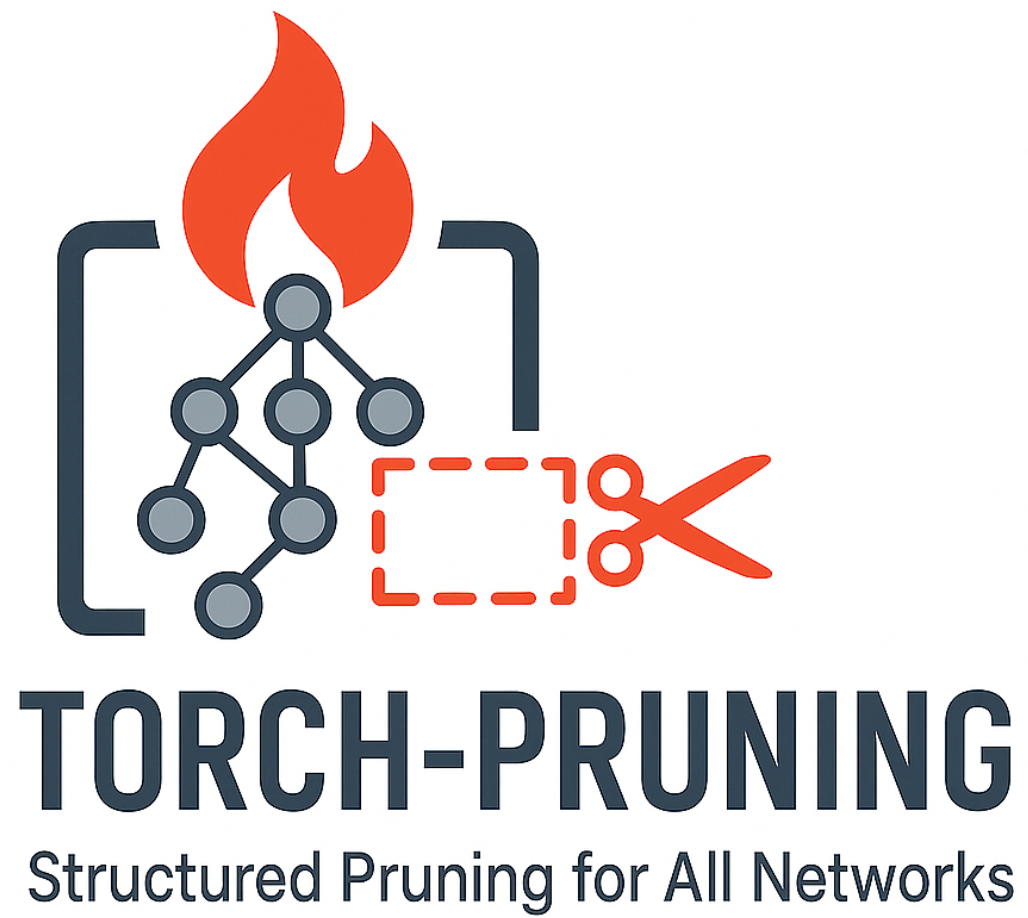
Torch-Pruning (TP) is a framework for structural pruning with the following features:
- General-purpose Pruning Toolkit: TP enables structural pruning for a wide range of deep neural networks. Different from torch.nn.utils.prune that zeroizes parameters via masking, Torch-Pruning deploys an algorithm called ⚡ DepGraph to group and remove coupled parameters.
- Examples: Pruning off-the-shelf models from Huggingface, Timm, Torchvision, including Large Language Models (LLMs), Segment Anything Model (SAM), Diffusion Models, Vision Transformers, ConvNext, Yolov7, yolov8, Swin Transformers, BERT, FasterRCNN, SSD, ResNe(X)t, DenseNet, RegNet, DeepLab, etc. A detailed list can be found in 🎨 Examples.
For more technical details, please refer to our CVPR'23 paper.
DepGraph: Towards Any Structural Pruning
Gongfan Fang, Xinyin Ma, Mingli Song, Michael Bi Mi, Xinchao Wang
xML Lab, National University of Singapore
Update:
- 🔥 2025.03.24 Examples for pruning DeepSeek-R1-Distill.
- 🔥 2024.11.17 We are working to add more examples for LLMs, such as Llama-2/3, Phi-3, Qwen-2/2.5.
- 🔥 2024.09.27 Check our latest work, MaskLLM (NeurIPS 24 Spotlight), for learnable semi-structured sparsity of LLMs.
- 🔥 2024.07.20 Add Isomorphic Pruning (ECCV'24). A SOTA method for Vision Transformers and Modern CNNs.
Contact Us:
Please do not hesitate to open an issue if you encounter any problems with the library or the paper.
Or Join our WeChat group for more discussions: ✉️ Group-2 (>200/500), ✉️ Group-1 (500/500, FULL).
Table of Contents
- Installation
- Quickstart
- Citation
Installation
Torch-Pruning only relies on PyTorch and Numpy, and it is compatible with PyTorch 1.x and 2.x. To install the latest version, run the following command:
pip install torch-pruning --upgrade
For editable installation:
git clone https://github.com/VainF/Torch-Pruning.git
cd Torch-Pruning && pip install -e .
Quickstart
Here we provide a quick start for Torch-Pruning. More explained details can be found in Tutorals
Why Torch-Pruning?
In structural pruning, the removal of a single parameter may affect multiple layers. For example, pruning an output dimension of a linear layer will require the removal of the corresponding input dimension in the following linear layer as shown in (a). This dependency between layers makes it challenging to prune complicated networks manually. Torch-Pruning addresses this issue by introducing a graph-based algorithm called DepGraph to automatically identify dependencies and collect groups for pruning.

How It Works: DepGraph
[!IMPORTANT]
Please make sure that AutoGrad is enabled since TP will analyze the model structure with the Pytorch AutoGrad. This means we need to removetorch.no_grad()or something similar when building the dependency graph.
import torch
from torchvision.models import resnet18
import torch_pruning as tp
model = resnet18(pretrained=True).eval()
# 1. Build dependency graph for a resnet18. This requires a dummy input for forwarding
DG = tp.DependencyGraph().build_dependency(model, example_inputs=torch.randn(1,3,224,224))
# 2. To prune the output channels of model.conv1, we need to find the corresponding group with a pruning function and pruning indices.
group = DG.get_pruning_group( model.conv1, tp.prune_conv_out_channels, idxs=[2, 6, 9] )
# 3. Do the pruning
if DG.check_pruning_group(group): # avoid over-pruning, i.e., channels=0.
group.prune()
# 4. Save & Load
model.zero_grad() # clear gradients to avoid a large file size
torch.save(model, 'model.pth') # !! no .state_dict here since the structure has been changed after pruning
model = torch.load('model.pth') # load the pruned model. you may need torch.load('model.pth', weights_only=False) for PyTorch 2.6.0+.
The above example shows the core algorithm, DepGraph, that captures the dependencies in structural pruning. The target layer model.conv1 is coupled with multiple layers, necessitating their simultaneous removal in structural pruning. We can print the group to take a look at the internal dependencies. In the subsequent outputs, "A => B" indicates that pruning operation "A" triggers pruning operation "B." The first group[0] refers to the root of pruning. For more details about grouping, please refer to Wiki - DepGraph & Group.
print(group.details()) # or print(group)
--------------------------------
Pruning Group
--------------------------------
[0] prune_out_channels on conv1 (Conv2d(3, 61, kernel_size=(7, 7), stride=(2, 2), padding=(3, 3), bias=False)) => prune_out_channels on conv1 (Conv2d(3, 61, kernel_size=(7, 7), stride=(2, 2), padding=(3, 3), bias=False)), idxs (3) =[2, 6, 9] (Pruning Root)
[1] prune_out_channels on conv1 (Conv2d(3, 61, kernel_size=(7, 7), stride=(2, 2), padding=(3, 3), bias=False)) => prune_out_channels on bn1 (BatchNorm2d(61, eps=1e-05, momentum=0.1, affine=True, track_running_stats=True)), idxs (3) =[2, 6, 9]
[2] prune_out_channels on bn1 (BatchNorm2d(61, eps=1e-05, momentum=0.1, affine=True, track_running_stats=True)) => prune_out_channels on _ElementWiseOp_20(ReluBackward0), idxs (3) =[2, 6, 9]
[3] prune_out_channels on _ElementWiseOp_20(ReluBackward0) => prune_out_channels on _ElementWiseOp_19(MaxPool2DWithIndicesBackward0), idxs (3) =[2, 6, 9]
[4] prune_out_channels on _ElementWiseOp_19(MaxPool2DWithIndicesBackward0) => prune_out_channels on _ElementWiseOp_18(AddBackward0), idxs (3) =[2, 6, 9]
[5] prune_out_channels on _ElementWiseOp_19(MaxPool2DWithIndicesBackward0) => prune_in_channels on layer1.0.conv1 (Conv2d(61, 64, kernel_size=(3, 3), stride=(1, 1), padding=(1, 1), bias=False)), idxs (3) =[2, 6, 9]
[6] prune_out_channels on _ElementWiseOp_18(AddBackward0) => prune_out_channels on layer1.0.bn2 (BatchNorm2d(61, eps=1e-05, momentum=0.1, affine=True, track_running_stats=True)), idxs (3) =[2, 6, 9]
[7] prune_out_channels on _ElementWiseOp_18(AddBackward0) => prune_out_channels on _ElementWiseOp_17(ReluBackward0), idxs (3) =[2, 6, 9]
[8] prune_out_channels on _ElementWiseOp_17(ReluBackward0) => prune_out_channels on _ElementWiseOp_16(AddBackward0), idxs (3) =[2, 6, 9]
[9] prune_out_channels on _ElementWiseOp_17(ReluBackward0) => prune_in_channels on layer1.1.conv1 (Conv2d(61, 64, kernel_size=(3, 3), stride=(1, 1), padding=(1, 1), bias=False)), idxs (3) =[2, 6, 9]
[10] prune_out_channels on _ElementWiseOp_16(AddBackward0) => prune_out_channels on layer1.1.bn2 (BatchNorm2d(61, eps=1e-05, momentum=0.1, affine=True, track_running_stats=True)), idxs (3) =[2, 6, 9]
[11] prune_out_channels on _ElementWiseOp_16(AddBackward0) => prune_out_channels on _ElementWiseOp_15(ReluBackward0), idxs (3) =[2, 6, 9]
[12] prune_out_channels on _ElementWiseOp_15(ReluBackward0) => prune_in_channels on layer2.0.downsample.0 (Conv2d(61, 128, kernel_size=(1, 1), stride=(2, 2), bias=False)), idxs (3) =[2, 6, 9]
[13] prune_out_channels on _ElementWiseOp_15(ReluBackward0) => prune_in_channels on layer2.0.conv1 (Conv2d(61, 128, kernel_size=(3, 3), stride=(2, 2), padding=(1, 1), bias=False)), idxs (3) =[2, 6, 9]
[14] prune_out_channels on layer1.1.bn2 (BatchNorm2d(61, eps=1e-05, momentum=0.1, affine=True, track_running_stats=True)) => prune_out_channels on layer1.1.conv2 (Conv2d(64, 61, kernel_size=(3, 3), stride=(1, 1), padding=(1, 1), bias=False)), idxs (3) =[2, 6, 9]
[15] prune_out_channels on layer1.0.bn2 (BatchNorm2d(61, eps=1e-05, momentum=0.1, affine=True, track_running_stats=True)) => prune_out_channels on layer1.0.conv2 (Conv2d(64, 61, kernel_size=(3, 3), stride=(1, 1), padding=(1, 1), bias=False)), idxs (3) =[2, 6, 9]
--------------------------------
How to scan all groups (Advanced):
There might be many groups in a model. We can use DG.get_all_groups(ignored_layers, root_module_types) to scan all prunable groups sequentially. Each group will begin with a layer that matches the one nn.Module class in root_module_types. The ignored_layers parameter is used to skip some layers that should not be pruned. For example, we can skip the first convolution layer in a ResNet model.
for group in DG.get_all_groups(ignored_layers=[model.conv1], root_module_types=[nn.Conv2d, nn.Linear]):
# Handle groups in sequential order
idxs = [2,4,6] # your pruning indices, feel free to change them
group.prune(idxs=idxs)
print(group)
High-level Pruners
[!NOTE]
The pruning ratio: In TP, thepruning_ratiorefers to the pruning ratio of channels/dims. Since both in & out dims will be removed by $p$, the actualparameter_pruning_ratioof will be roughly $1-(1-p)^2$. To remove 50% of parameters, you may usepruning_ratio=0.30instead, which leads to the actual parameter pruning ratio of `$1-(1-0.3)^2=0.51$ (51% parameters removed).
With DepGraph, we developed several high-level pruners to facilitate effortless pruning. By specifying the desired channel pruning ratio, the pruner will scan all prunable groups, estimate weight importance and perform pruning. You can fine-tune the remaining weights using your own training code. For detailed information on this process, please refer to this tutorial, which shows how to implement a Network Slimming (ICCV 2017) pruner from scratch. Additionally, a more practical example is available in VainF/Isomorphic-Pruning for ViT and ConvNext pruning.
import torch
from torchvision.models import resnet18
import torch_pruning as tp
model = resnet18(pretrained=True)
example_inputs = torch.randn(1, 3, 224, 224)
# 1. Importance criterion, here we calculate the L2 Norm of grouped weights as the importance score
imp = tp.importance.GroupMagnitudeImportance(p=2)
# 2. Initialize a pruner with the model and the importance criterion
ignored_layers = []
for m in model.modules():
if isinstance(m, torch.nn.Linear) and m.out_features == 1000:
ignored_layers.append(m) # DO NOT prune the final classifier!
pruner = tp.pruner.BasePruner( # We can always choose BasePruner if sparse training is not required.
model,
example_inputs,
importance=imp,
pruning_ratio=0.5, # remove 50% channels, ResNet18 = {64, 128, 256, 512} => ResNet18_Half = {32, 64, 128, 256}
# pruning_ratio_dict = {model.conv1: 0.2, model.layer2: 0.8}, # customized pruning ratios for layers or blocks
ignored_layers=ignored_layers,
round_to=8, # It's recommended to round dims/channels to 4x or 8x for acceleration. Please see: https://docs.nvidia.com/deeplearning/performance/dl-performance-convolutional/index.html
)
# 3. Prune the model
base_macs, base_nparams = tp.utils.count_ops_and_params(model, example_inputs)
tp.utils.print_tool.before_pruning(model) # or print(model)
pruner.step()
tp.utils.print_tool.after_pruning(model) # or print(model), this util will show the difference before and after pruning
macs, nparams = tp.utils.count_ops_and_params(model, example_inputs)
print(f"MACs: {base_macs/1e9} G -> {macs/1e9} G, #Params: {base_nparams/1e6} M -> {nparams/1e6} M")
# 4. finetune the pruned model using your own code.
# finetune(model)
# ...
Output
The model difference before and after pruning will be highlighted by something like (conv1): Conv2d(3, 64, kernel_size=(7, 7), stride=(2, 2), padding=(3, 3), bias=False) => (conv1): Conv2d(3, 32, kernel_size=(7, 7), stride=(2, 2), padding=(3, 3), bias=False).
ResNet(
(conv1): Conv2d(3, 64, kernel_size=(7, 7), stride=(2, 2), padding=(3, 3), bias=False) => (conv1): Conv2d(3, 32, kernel_size=(7, 7), stride=(2, 2), padding=(3, 3), bias=False)
(bn1): BatchNorm2d(64, eps=1e-05, momentum=0.1, affine=True, track_running_stats=True) => (bn1): BatchNorm2d(32, eps=1e-05, momentum=0.1, affine=True, track_running_stats=True)
(relu): ReLU(inplace=True)
(maxpool): MaxPool2d(kernel_size=3, stride=2, padding=1, dilation=1, ceil_mode=False)
...
(1): BasicBlock(
(conv1): Conv2d(512, 512, kernel_size=(3, 3), stride=(1, 1), padding=(1, 1), bias=False) => (conv1): Conv2d(256, 256, kernel_size=(3, 3), stride=(1, 1), padding=(1, 1), bias=False)
(bn1): BatchNorm2d(512, eps=1e-05, momentum=0.1, affine=True, track_running_stats=True) => (bn1): BatchNorm2d(256, eps=1e-05, momentum=0.1, affine=True, track_running_stats=True)
(relu): ReLU(inplace=True)
(conv2): Conv2d(512, 512, kernel_size=(3, 3), stride=(1, 1), padding=(1, 1), bias=False) => (conv2): Conv2d(256, 256, kernel_size=(3, 3), stride=(1, 1), padding=(1, 1), bias=False)
(bn2): BatchNorm2d(512, eps=1e-05, momentum=0.1, affine=True, track_running_stats=True) => (bn2): BatchNorm2d(256, eps=1e-05, momentum=0.1, affine=True, track_running_stats=True)
)
)
(avgpool): AdaptiveAvgPool2d(output_size=(1, 1))
(fc): Linear(in_features=512, out_features=1000, bias=True) => (fc): Linear(in_features=256, out_features=1000, bias=True)
)
MACs: 1.822177768 G -> 0.487202536 G, #Params: 11.689512 M -> 3.05588 M
Global Pruning and Isomorphic Pruning
Global pruning performs importance ranking on all layers, which has the potential to find better structures. This can be easily achieved by setting global_pruning=True in the pruner. While this strategy can possibly offer performance advantages, it also carries the potential of overly pruning specific layers, resulting in a substantial decline in overall performance. We provide an alternative algorithm called Isomorphic Pruning to alleviate this issue, which can be enabled with isomorphic=True. Comprehensive examples for ViT & ConvNext pruning are available in this project.
pruner = tp.pruner.BasePruner(
...
isomorphic=True, # enable isomorphic pruning to improve global ranking
global_pruning=True, # global pruning
)

Pruning Ratios
The argument pruning_ratio detemines the default pruning ratio. If you want to customize the pruning ratio for some layers or blocks, you can use pruning_ratio_dict. The key of the dict can be a single nn.Module or a tuple of nn.Module. In the second case, all modules in the tuple will form a scope and share the user-defined pruning ratio and compete to be pruned.
pruner = tp.pruner.BasePruner(
...
global_pruning=True,
pruning_ratio=0.5, # default pruning ratio
# layer1 & layer2 will share a total pruning ratio of 0.4 while layer 3 will have a pruning ratio of 0.2
pruning_ratio_dict = {(model.layer1, model.layer2): 0.4, model.layer3: 0.2},
)
Sparse Training (Optional)
Some pruners like BNScalePruner and GroupNormPruner support sparse training. This can be easily achieved by inserting pruner.update_regularizer() and pruner.regularize(model) in your standard training loops. The pruner will accumulate the regularization gradients to .grad. Sparse training is optional and may not always gaurentee better performance. Be careful when using it.
for epoch in range(epochs):
model.train()
pruner.update_regularizer() # <== initialize regularizer
for i, (data, target) in enumerate(train_loader):
data, target = data.to(device), target.to(device)
optimizer.zero_grad()
out = model(data)
loss = F.cross_entropy(out, target)
loss.backward() # after loss.backward()
pruner.regularize(model) # <== for sparse training
optimizer.step() # before optimizer.step()
Interactive Pruning
All high-level pruners offer support for interactive pruning. You can utilize the method pruner.step(interactive=True) to retrieve all the groups and interactively prune them by calling group.prune(). This feature is particularly useful if you want to control or monitor the pruning process.
for i in range(iterative_steps):
for group in pruner.step(interactive=True): # Warning: groups must be handled sequentially. Do not keep them as a list.
print(group)
# do whatever you like with the group
dep, idxs = group[0] # get the idxs
target_module = dep.target.module # get the root module
pruning_fn = dep.handler # get the pruning function
group.prune()
# group.prune(idxs=[0, 2, 6]) # It is even possible to change the pruning behaviour with the idxs parameter
macs, nparams = tp.utils.count_ops_and_params(model, example_inputs)
# finetune your model here
# finetune(model)
# ...
Pruning by Masking
It is possible to implement masking-based Pruning leveraging interactive=True, which zeros out parameters without removing them. An example can be found in tests/test_soft_pruning.py
Group-level Pruning
With DepGraph, it is easy to design some "group-level" importance scores to estimate the importance of a whole group rather than a single layer. This feature can be also used to sparsify coupled layers, making all the to-be-pruned parameters consistently sparse. In Torch-pruning, all pruners work at the group level. Check the following results to see how grouping improves the performance of pruning.

- Pruning a ResNet50 pre-trained on ImageNet-1K without fine-tuning.
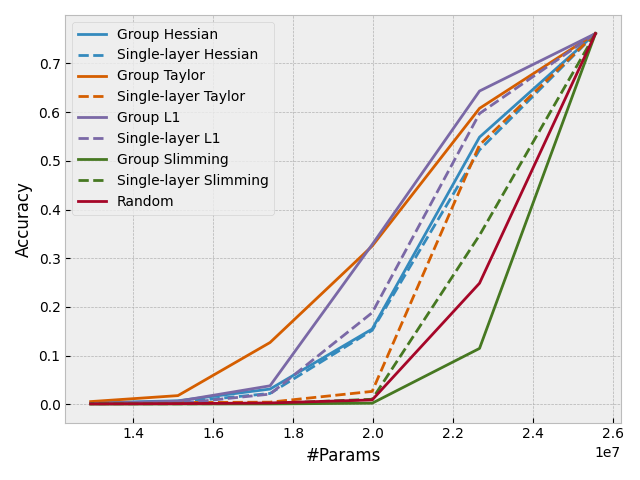
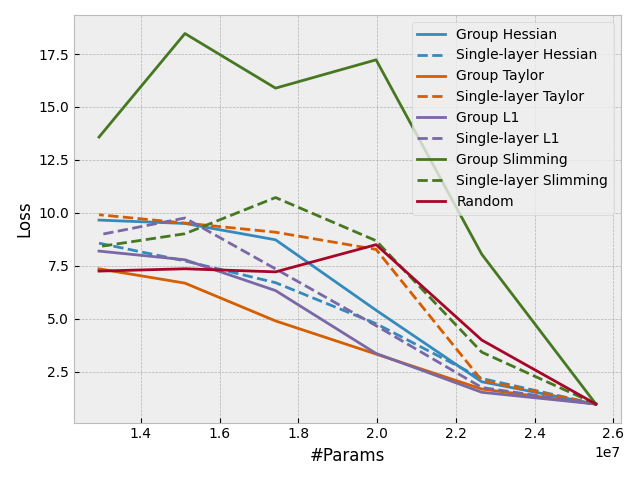
- Pruning a Vision Transformer pre-trained on ImageNet-1K without fine-tuning.
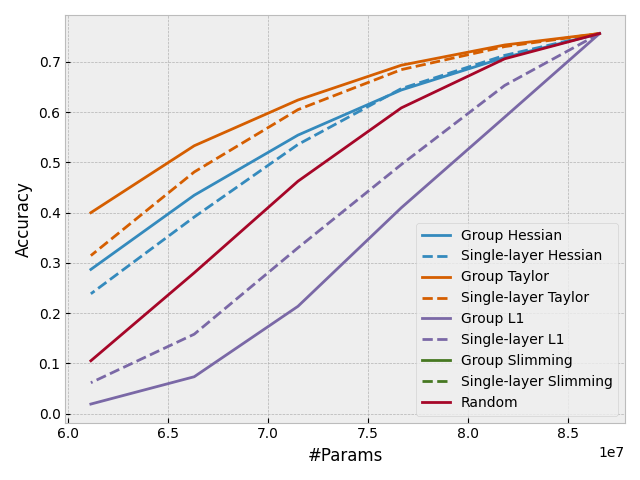
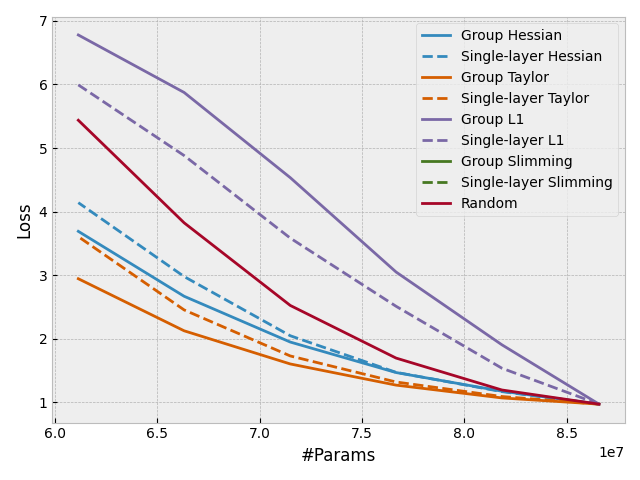
Modify static attributes or forward functions
In some implementations, model forwarding might rely on static attributes. For example in convformer_s18 of timm, we have self.shape which will be changed after pruning. These attributes should be updated manually since it is impossible for TP to know the purpose of these attributes.
class Scale(nn.Module):
"""
Scale vector by element multiplications.
"""
def __init__(self, dim, init_value=1.0, trainable=True, use_nchw=True):
super().__init__()
self.shape = (dim, 1, 1) if use_nchw else (dim,) # static shape, which should be updated after pruning
self.scale = nn.Parameter(init_value * torch.ones(dim), requires_grad=trainable)
def forward(self, x):
return x * self.scale.view(self.shape) # => x * self.scale.view(-1, 1, 1), this works for pruning
Save and Load
The following script saves the whole model object (structure+weights) as a 'model.pth'. You can load it using the standard PyTorch API. Just remember that we save and load the whole model without .state_dict or .load_state_dict, since the pruned sturctured will be different from the original definition in your model.py.
model.zero_grad() # Remove gradients
torch.save(model, 'model.pth') # without .state_dict
model = torch.load('model.pth') # load the pruned model
# For PyTorch 2.6.0+, you may need weights_only=False to enable model loading
# model = torch.load('model.pth', weights_only=False)
Low-level Pruning Functions
In Torch-Pruning, we provide a series of low-level pruning functions that only prune a single layer or module. To manually prune the model.conv1 of a ResNet-18, the pruning pipeline should look like this:
tp.prune_conv_out_channels( model.conv1, idxs=[2,6,9] )
# fix the broken dependencies manually
tp.prune_batchnorm_out_channels( model.bn1, idxs=[2,6,9] )
tp.prune_conv_in_channels( model.layer2[0].conv1, idxs=[2,6,9] )
...
The following pruning functions are available:
'prune_conv_out_channels',
'prune_conv_in_channels',
'prune_depthwise_conv_out_channels',
'prune_depthwise_conv_in_channels',
'prune_batchnorm_out_channels',
'prune_batchnorm_in_channels',
'prune_linear_out_channels',
'prune_linear_in_channels',
'prune_prelu_out_channels',
'prune_prelu_in_channels',
'prune_layernorm_out_channels',
'prune_layernorm_in_channels',
'prune_embedding_out_channels',
'prune_embedding_in_channels',
'prune_parameter_out_channels',
'prune_parameter_in_channels',
'prune_multihead_attention_out_channels',
'prune_multihead_attention_in_channels',
'prune_groupnorm_out_channels',
'prune_groupnorm_in_channels',
'prune_instancenorm_out_channels',
'prune_instancenorm_in_channels',
Customized Layers
Please refer to examples/transformers/prune_hf_swin.py, which implements a new pruner for the customized module SwinPatchMerging. Another simple example is available at tests/test_customized_layer.py.
Reproduce Paper Results
Please see reproduce.
Our results on {ResNet-56 / CIFAR-10 / 2.00x}
| Method | Base (%) | Pruned (%) | $\Delta$ Acc (%) | Speed Up |
|---|---|---|---|---|
| NIPS [1] | - | - | -0.03 | 1.76x |
| Geometric [2] | 93.59 | 93.26 | -0.33 | 1.70x |
| Polar [3] | 93.80 | 93.83 | +0.03 | 1.88x |
| CP [4] | 92.80 | 91.80 | -1.00 | 2.00x |
| AMC [5] | 92.80 | 91.90 | -0.90 | 2.00x |
| HRank [6] | 93.26 | 92.17 | -0.09 | 2.00x |
| SFP [7] | 93.59 | 93.36 | +0.23 | 2.11x |
| ResRep [8] | 93.71 | 93.71 | +0.00 | 2.12x |
| Ours-L1 | 93.53 | 92.93 | -0.60 | 2.12x |
| Ours-BN | 93.53 | 93.29 | -0.24 | 2.12x |
| Ours-Group | 93.53 | 93.77 | +0.38 | 2.13x |
Latency
Latency test on ResNet-50, Batch Size=64.
[Iter 0] Pruning ratio: 0.00, MACs: 4.12 G, Params: 25.56 M, Latency: 45.22 ms +- 0.03 ms
[Iter 1] Pruning ratio: 0.05, MACs: 3.68 G, Params: 22.97 M, Latency: 46.53 ms +- 0.06 ms
[Iter 2] Pruning ratio: 0.10, MACs: 3.31 G, Params: 20.63 M, Latency: 43.85 ms +- 0.08 ms
[Iter 3] Pruning ratio: 0.15, MACs: 2.97 G, Params: 18.36 M, Latency: 41.22 ms +- 0.10 ms
[Iter 4] Pruning ratio: 0.20, MACs: 2.63 G, Params: 16.27 M, Latency: 39.28 ms +- 0.20 ms
[Iter 5] Pruning ratio: 0.25, MACs: 2.35 G, Params: 14.39 M, Latency: 34.60 ms +- 0.19 ms
[Iter 6] Pruning ratio: 0.30, MACs: 2.02 G, Params: 12.46 M, Latency: 33.38 ms +- 0.27 ms
[Iter 7] Pruning ratio: 0.35, MACs: 1.74 G, Params: 10.75 M, Latency: 31.46 ms +- 0.20 ms
[Iter 8] Pruning ratio: 0.40, MACs: 1.50 G, Params: 9.14 M, Latency: 29.04 ms +- 0.19 ms
[Iter 9] Pruning ratio: 0.45, MACs: 1.26 G, Params: 7.68 M, Latency: 27.47 ms +- 0.28 ms
[Iter 10] Pruning ratio: 0.50, MACs: 1.07 G, Params: 6.41 M, Latency: 20.68 ms +- 0.13 ms
[Iter 11] Pruning ratio: 0.55, MACs: 0.85 G, Params: 5.14 M, Latency: 20.48 ms +- 0.21 ms
[Iter 12] Pruning ratio: 0.60, MACs: 0.67 G, Params: 4.07 M, Latency: 18.12 ms +- 0.15 ms
[Iter 13] Pruning ratio: 0.65, MACs: 0.53 G, Params: 3.10 M, Latency: 15.19 ms +- 0.01 ms
[Iter 14] Pruning ratio: 0.70, MACs: 0.39 G, Params: 2.28 M, Latency: 13.47 ms +- 0.01 ms
[Iter 15] Pruning ratio: 0.75, MACs: 0.29 G, Params: 1.61 M, Latency: 10.07 ms +- 0.01 ms
[Iter 16] Pruning ratio: 0.80, MACs: 0.18 G, Params: 1.01 M, Latency: 8.96 ms +- 0.02 ms
[Iter 17] Pruning ratio: 0.85, MACs: 0.10 G, Params: 0.57 M, Latency: 7.03 ms +- 0.04 ms
[Iter 18] Pruning ratio: 0.90, MACs: 0.05 G, Params: 0.25 M, Latency: 5.81 ms +- 0.03 ms
[Iter 19] Pruning ratio: 0.95, MACs: 0.01 G, Params: 0.06 M, Latency: 5.70 ms +- 0.03 ms
[Iter 20] Pruning ratio: 1.00, MACs: 0.01 G, Params: 0.06 M, Latency: 5.71 ms +- 0.03 ms
Series of Works
DepGraph: Towards Any Structural Pruning [Project] [Paper]
Gongfan Fang, Xinyin Ma, Mingli Song, Michael Bi Mi, Xinchao Wang
CVPR 2023
Isomorphic Pruning for Vision Models [Project] [Arxiv]
Gongfan Fang, Xinyin Ma, Michael Bi Mi, Xinchao Wang
ECCV 2024
LLM-Pruner: On the Structural Pruning of Large Language Models [Project] [arXiv]
Xinyin Ma, Gongfan Fang, Xinchao Wang
NeurIPS 2023
Structural Pruning for Diffusion Models [Project] [arxiv]
Gongfan Fang, Xinyin Ma, Xinchao Wang
NeurIPS 2023
DeepCache: Accelerating Diffusion Models for Free [Project] [Arxiv]
Xinyin Ma, Gongfan Fang, and Xinchao Wang
CVPR 2024
SlimSAM: 0.1% Data Makes Segment Anything Slim [Project] [Arxiv]
Zigeng Chen, Gongfan Fang, Xinyin Ma, Xinchao Wang
Preprint 2023
Citation
@inproceedings{fang2023depgraph,
title={Depgraph: Towards any structural pruning},
author={Fang, Gongfan and Ma, Xinyin and Song, Mingli and Mi, Michael Bi and Wang, Xinchao},
booktitle={Proceedings of the IEEE/CVF Conference on Computer Vision and Pattern Recognition},
pages={16091--16101},
year={2023}
}
Project details
Release history Release notifications | RSS feed
Download files
Download the file for your platform. If you're not sure which to choose, learn more about installing packages.
Source Distribution
Built Distribution
File details
Details for the file torch_pruning-1.6.0.tar.gz.
File metadata
- Download URL: torch_pruning-1.6.0.tar.gz
- Upload date:
- Size: 87.1 kB
- Tags: Source
- Uploaded using Trusted Publishing? No
- Uploaded via: twine/6.1.0 CPython/3.9.23
File hashes
| Algorithm | Hash digest | |
|---|---|---|
| SHA256 |
9eca1ad50ec167e14f367846affc46d3ab64e9b54be3ea5da3eb888338a15bae
|
|
| MD5 |
a8ebf82f39c80ab214124c7d46c4fadd
|
|
| BLAKE2b-256 |
b472c15b4b201ce49f7f998101c3cbd18ccb1824d73536a6bb6167346906f416
|
File details
Details for the file torch_pruning-1.6.0-py3-none-any.whl.
File metadata
- Download URL: torch_pruning-1.6.0-py3-none-any.whl
- Upload date:
- Size: 68.4 kB
- Tags: Python 3
- Uploaded using Trusted Publishing? No
- Uploaded via: twine/6.1.0 CPython/3.9.23
File hashes
| Algorithm | Hash digest | |
|---|---|---|
| SHA256 |
6fcce223dfb9825dc69807ebf4992f67fe74806fdb566cc73eadc14bf0e2d4c2
|
|
| MD5 |
84c6fc8c46ae916105ccd75b8abb5b1a
|
|
| BLAKE2b-256 |
d652db123b120843b9a477637b9812c04e05d6b0dbb060abb286741be558f5b4
|

















